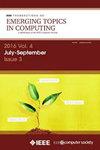A Novel Adaptive $360^{\circ }$360∘ Livestreaming With Graph Representation Learning Based FoV Prediction
IF 5.4
2区 计算机科学
Q1 COMPUTER SCIENCE, INFORMATION SYSTEMS
IEEE Transactions on Emerging Topics in Computing
Pub Date : 2024-08-09
DOI:10.1109/TETC.2024.3435002
引用次数: 0
Abstract
The exceptionally high bandwidth requirements associated with the delivery of live利用基于图表示学习的 FoV 预测进行 360° 自适应直播的新方法
在当前的网络环境下,与360美元视频内容直播相关的极高带宽要求构成了重大挑战。解决这一带宽挑战的一个途径是利用有限的网络资源以高分辨率发送用户的视场(FoV)图块,而不是以高质量传输所有帧组件。然而,由于缺乏对用户观看行为的预先了解,精确预测360美元直播视频内容分发的FoV仍然是一项复杂的工作。在本文中,我们提出了一种新的$360^{\circ}$传输框架GL360,它采用图表示学习进行视场预测。首先,我们利用动态异构关系图卷积网络(RGCN)分析全景视频中用户和贴图之间的交互,该网络促进了高效的用户和贴图嵌入表示学习。其次,我们提出了一种基于在线动态异构图学习(DHGL)的算法,在有限的先验知识下动态捕获用户观看行为的时变特征。此外,我们设计了一个感知fov的内容传递算法,允许边缘服务器为每个访问的用户确定视频块的分辨率。基于真实轨迹的实验结果表明,我们的解决方案在视场预测和网络性能方面优于其他四种解决方案。
本文章由计算机程序翻译,如有差异,请以英文原文为准。
求助全文
约1分钟内获得全文
求助全文
来源期刊

IEEE Transactions on Emerging Topics in Computing
Computer Science-Computer Science (miscellaneous)
CiteScore
12.10
自引率
5.10%
发文量
113
期刊介绍:
IEEE Transactions on Emerging Topics in Computing publishes papers on emerging aspects of computer science, computing technology, and computing applications not currently covered by other IEEE Computer Society Transactions. Some examples of emerging topics in computing include: IT for Green, Synthetic and organic computing structures and systems, Advanced analytics, Social/occupational computing, Location-based/client computer systems, Morphic computer design, Electronic game systems, & Health-care IT.
 求助内容:
求助内容: 应助结果提醒方式:
应助结果提醒方式:


